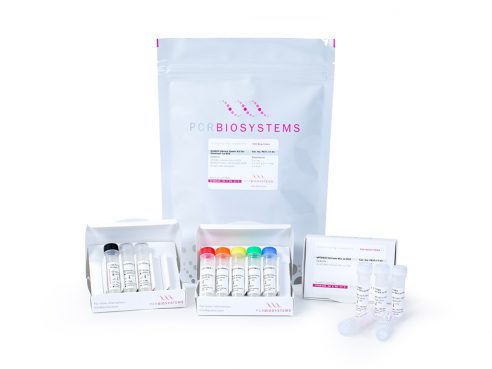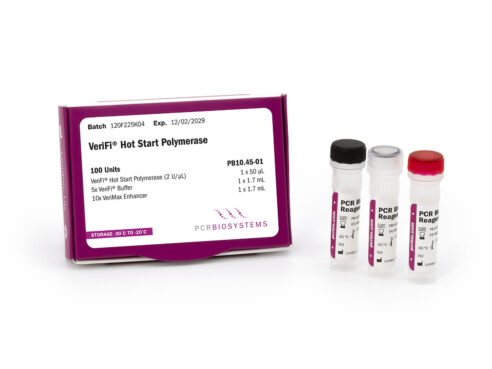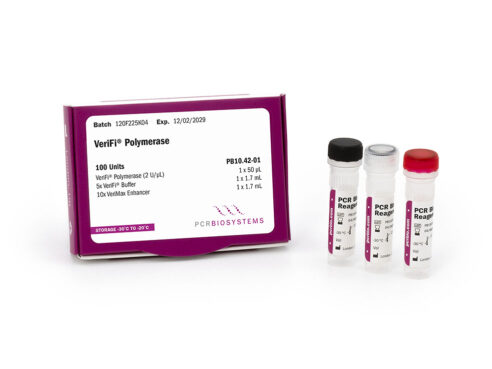VeriFi® Library Amplification Mix for NGS
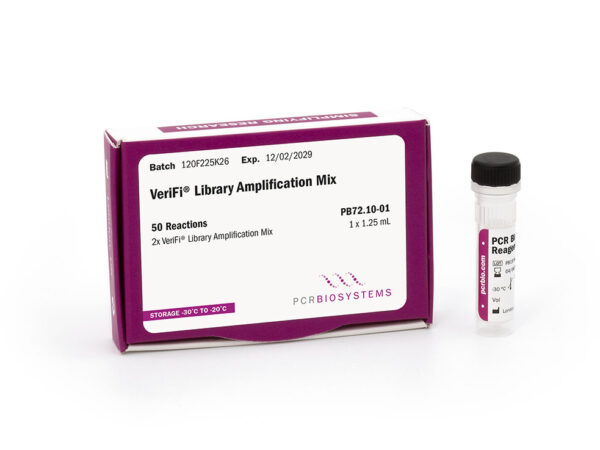
VeriFi® Library Amplification Mix is ideal for NGS workflows and challenging PCRs. Combining a powerful and robust proofreading enzyme, greatly reduced GC-dependent bias, and AptaLock™ hot start technology, this mix enables precise PCR, regardless the target you are sequencing.
A superior proofreading Pfu polymerase in a specially formulated 2x PCR ready mix designed for NGS library amplification with reduced GC bias1. This cutting-edge PCR mix offers market leading performance enabling the acquisition of superior quality datasets with a higher number of unique reads2. The mix can be combined with our library quantification kit during NGS library preparation.
Features:
- Low GC bias, ideal for high GC/AT targets
- More unique reads per NGS dataset for superior data quality
- AptaLock™ hot start technology for maximum sensitivity and specificity
- 100x higher fidelity than Taq DNA polymerase
- Room temperature setup
- 2x ready mix for minimal pipetting
- Resistant to blood and chemical inhibitors
Application
- NGS library amplification
- Whole genome sequencing
- RNA-Seq
- Multiplex and high throughput PCR
- GC/AT rich target sequencing
- Metagenomic studies
VeriFi® Library Amplification Mix
VeriFi® Library Amplification Mix was created as a tool for researchers conducting next generation sequencing (NGS) studies. A key part of PCR-based NGS workflows is the amplification step during which a DNA or cDNA (in the case of RNA-Seq studies) library has been modified to contain appropriate adaptors for the intended sequencing platform and needs to be amplified before proceeding with the sequencing step.
To ensure accuracy of the final sequencing data, proofreading polymerases used in the amplification step of an NGS pipeline must have certain key characteristics, which are:
- High Fidelity, to minimise PCR errors in nucleotide incorporation.
- Strong multiplexing capability, to amplify varying fragment lengths in a library.
- Low sequence-dependent bias, particularly when dealing with complex (GC/AT-rich, or repetitive) sequences.
Additional features can also help improve library amplification mix performance, depending on the type of NGS study being undertaken. VeriFi® Library Amplification Mix is engineered with these features in mind. It is powered by our market leading VeriFi® Polymerase, with AptaLock™ hot start technology, in a novel 2x mix format. The mix contains reaction buffer, dNTPs, Mg2+, and enhancers that minimise GC-bias and enable reliable library amplification for Illumina sequencing platforms. Amplified libraries can easily be quantified using NGSBIO Library Quant Kit Blue for Illumina prior to sequencing.
Better quality NGS data
VeriFi® Library Amplification Mix was externally validated using Illumina-based sequencing in a blind comparison with three market-leading competitors. VeriFi® Library Amplification Mix consistently gave 2% more uniquely mapped reads than competitors for three different microbial genomes. Depending on sequencing platform being used, this small percentage can translate to 80,000 to 100,000,000 more unique reads. This leads to greater target sequence coverage and more accurate quantitative information, making sequencing experiments more cost-effective and resulting data more informative.
Reduced GC bias during NGS library amplification
Novel buffer composition makes VeriFi® Library Amplification Mix ideal for complex templates. Our research team has challenged this enzyme in PCRs on numerous difficult templates, demonstrating minimal bias during amplification at extremes of GC content ranging from 30% – 70%. With consistently better performance than all major competitors, these results ensure cutting edge performance of the mix regardless of the target sequence, to give you confidence when undertaking costly and laborious NGS experiments. In combination with a higher number of unique reads, discussed above, this feature makes VeriFi® Library Amplification Mix perfect for conducting metagenomic analyses.
AptaLock™ hot start technology
VeriFi® Library Amplification Mix is enhanced by PCRBIO’s innovative AptaLock™ hot start technology, a proprietary aptamer-like molecule that reversibly inhibits both the 3’-5’ exonuclease activity and 5’-3’ polymerase activity of the enzyme at ambient temperatures. The unique hot start molecule prevents primer dimer formation and non-specific amplification to maximise PCR sensitivity and specificity. This ensures amplification reactions can be set up at room temperature.
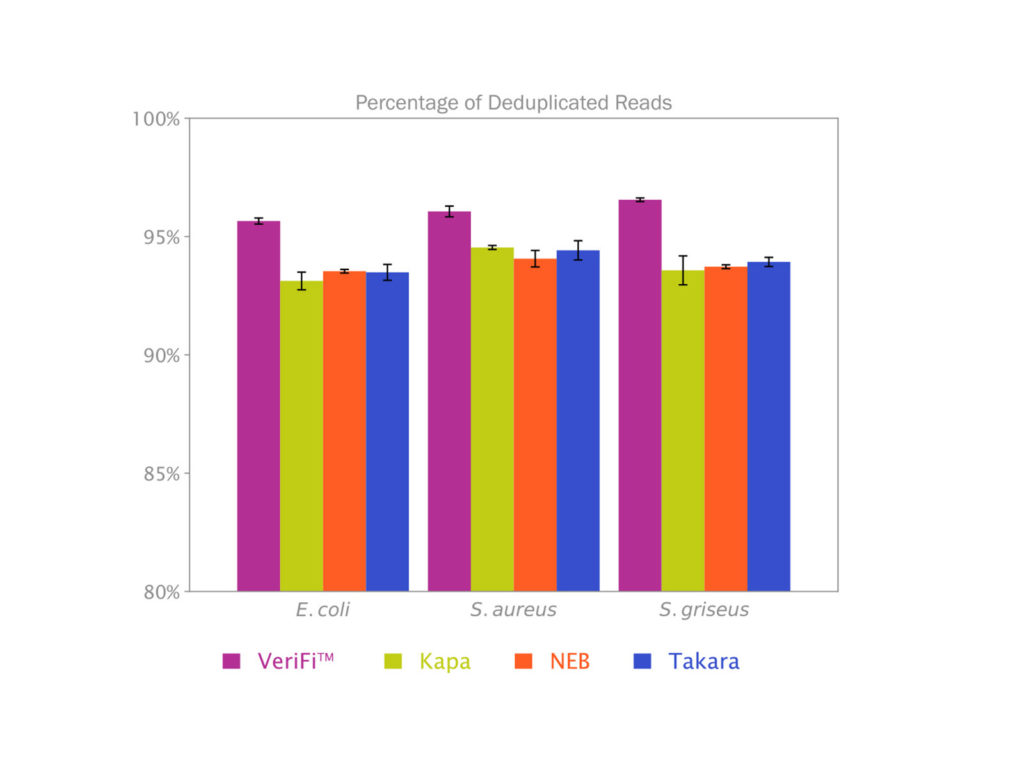
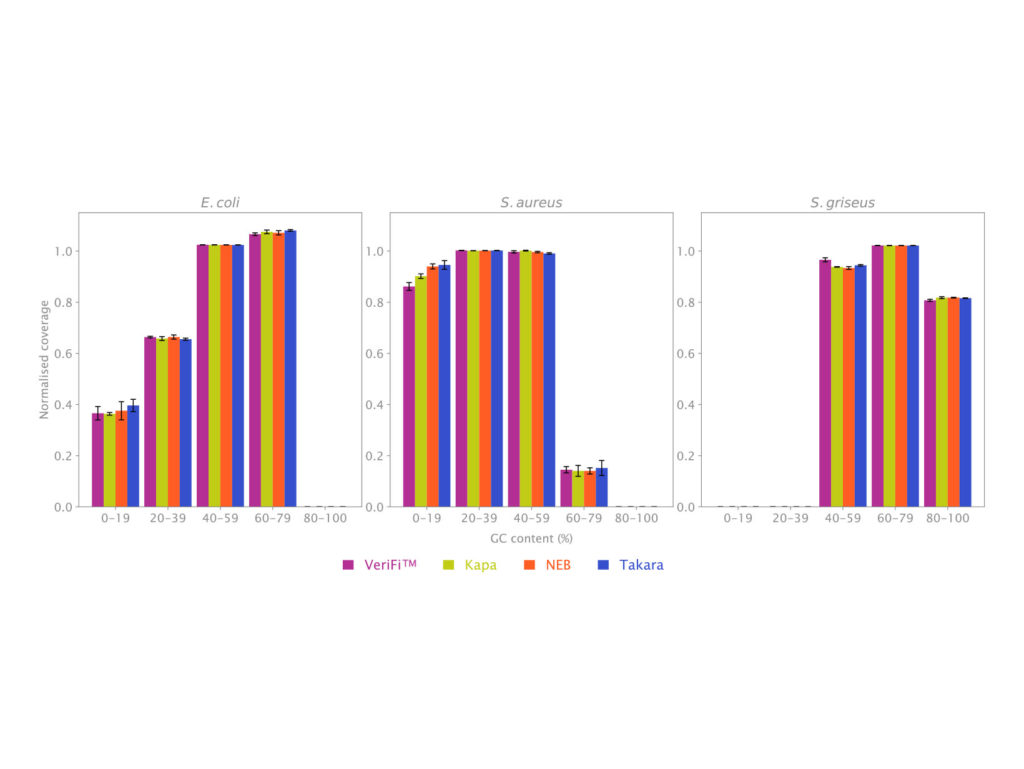
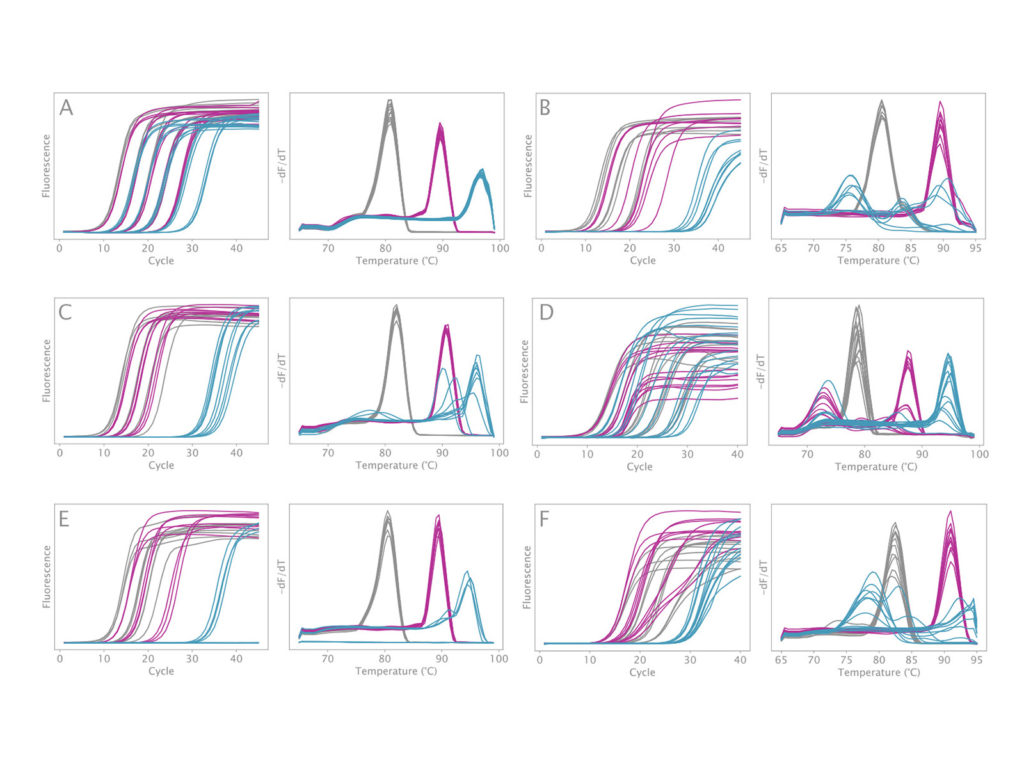
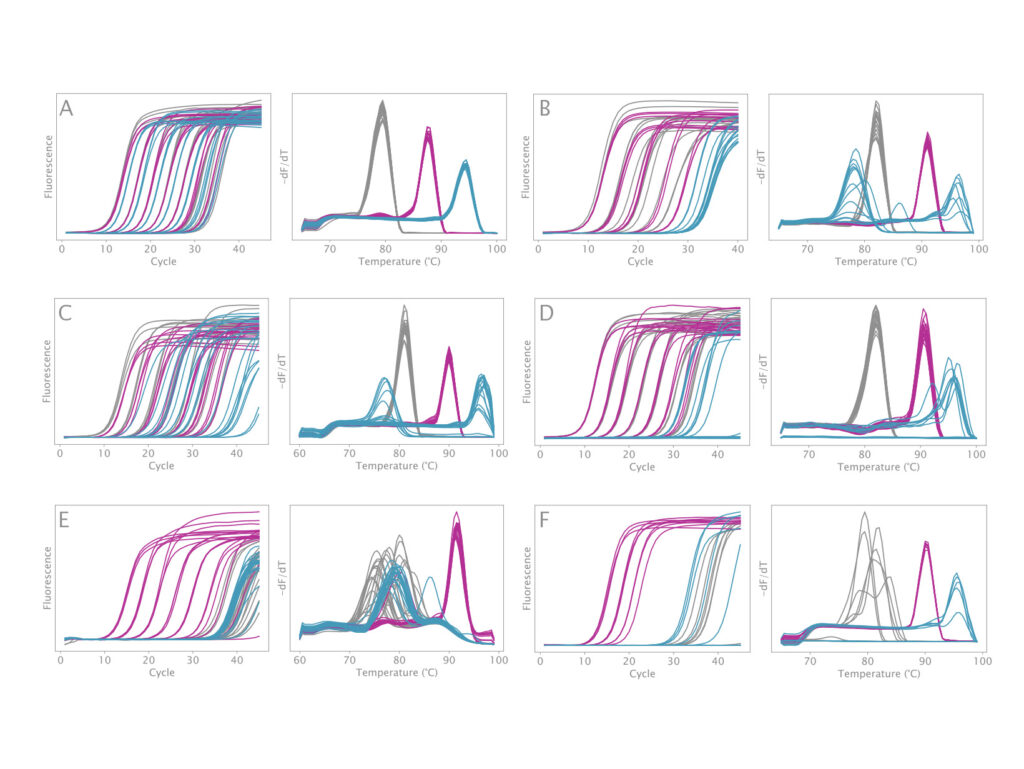
References
- Chen, Y.C., Liu, T., Yu, C.H., Chiang, T.Y., Hwang, C.C., Effects of GC Bias in Next-Generation-Sequencing Data on De Novo</i> Genome Assembly. PLOS ONE 8(4): e62856. ref=”https://doi.org/10.1371/journal.pone.0062856″>https://doi.org/10.1371/journal.pone.0062856
- Sims, D., Sudbery, I., Ilott, N. et al. Sequencing depth and coverage: key considerations in genomic analyses. Nat Rev Genet 15, 121–132 (2014). ref=”https://doi.org/10.1038/nrg3642″ target=”_blank” rel=”noopener”>l=”class=’yoast-text-mark’>er noopenhttps://doi.org/10.1038/nrg3642
Documents
Product Flyers
Product Manuals
Material Safety Data Sheets
Application Notes
Certificate of Analysis Finder
Specifications
VeriFi® Library Amplification Mix
Component
50 Reactions
250 Reactions
2x VeriFi Library Amplification Mix
1 x 1.25 mL
5 x 1.25 mL
VeriFi® Library Amplification Mix
Component
2x VeriFi Library Amplification Mix
50 Reactions
1 x 1.25 mL
250 Reactions
5 x 1.25 mL
Reaction Volume
Storage
50 μL
On arrival, products should be stored between -30 and -20 °C. If stored correctly the kit will retain full activity until the indicated expiry date.
Reaction Volume
50 μL
Storage
On arrival, products should be stored between -30 and -20 °C. If stored correctly the kit will retain full activity until the indicated expiry date.
FAQs
My amplified library is of poor quality, how can I improve it?
Increase denaturation temperature. Optimise annealing temperature and extension time. Optimise the amount of primers and template in the reaction. Make sure that the starting material is high quality.
Can I use VeriFi® Library Amplification Mix for methylation studies/amplification of bisulfite-treated DNA?
No. Pfu polymerases can only amplify uracil-containing targets after mutagenesis, which compromises PCR fidelity.
Can VeriFi® Library Amplification Mix be used in single cell NGS experiments?
VeriFi® Library Amplification Mix can be used for PCR-based enrichment of any type of DNA sequencing library.
I am struggling to amplify a target with high GC content, what should I do?
Increase denaturation temperature to 98-100 °C and increase the extension time.
What is the maximum target length I can amplify with VeriFi® Library Amplification Mix?
We have successfully amplified a 12 kb fragment containing GC-rich regions. Longer targets may also be successfully attempted.
Can I do multiplex PCR with VeriFi® Library Amplification Mix?
Yes. For most multiplex experiments we recommend using VeriFi® Hot Start Polymerase & Mixes (PB10.45-PB10.47 product catalogue numbers). However, VeriFi® Library Amplification Mix is also well suited for this purpose, particularly when one or more of the multiplexed targets is GC-rich or contains difficult or repetitive sequence regions.
Can I use VeriFi® Library Amplification Mix for standard PCR rather than library amplification?
Yes, please follow the relevant instructions in the product manual. VeriFi® Library Amplification Mix can be used in standard 3-step or 2-step cycling programs and is particularly well suited to amplifying targets with very high or very low GC content.
What NGS sequencing platforms can I use VeriFi® Library Amplification Mix for?
VeriFi® Library Amplification Mix has been extensively tested and validated on Illumina sequencing platforms with the P5 and P7 Illumina primers. The mix should work equally well in amplifying libraries with different adaptor sequences, intended for use on other sequencing platforms (e.g., Pac Bio and Oxford Nanopore Technologies), but this needs to be tested.
Do I need to include a purification step between adaptor ligation and library amplification with VeriFi® Library Amplification Mix?
We recommend including a purification step after adaptor ligation and size selection. This eliminates any potential buffer incompatibility and ensures that un-ligated adaptors are not amplified during library PCR enrichment.
What is the minimum template amount I can use for successful library amplification with VeriFi® Library Amplification Mix?
Do not use less than 10 ng template for NGS library amplification. A key factor in acquiring a high-quality amplified library is limiting the number of PCR cycles used. Using a higher number of cycles leads to greater chances of PCR induced errors and bias.
Features:
- Low GC bias, ideal for high GC/AT targets
- More unique reads per NGS dataset for superior data quality
- AptaLock™ hot start technology for maximum sensitivity and specificity
- 100x higher fidelity than Taq DNA polymerase
- Room temperature setup
- 2x ready mix for minimal pipetting
- Resistant to blood and chemical inhibitors
Application
- NGS library amplification
- Whole genome sequencing
- RNA-Seq
- Multiplex and high throughput PCR
- GC/AT rich target sequencing
- Metagenomic studies
VeriFi® Library Amplification Mix
VeriFi® Library Amplification Mix was created as a tool for researchers conducting next generation sequencing (NGS) studies. A key part of PCR-based NGS workflows is the amplification step during which a DNA or cDNA (in the case of RNA-Seq studies) library has been modified to contain appropriate adaptors for the intended sequencing platform and needs to be amplified before proceeding with the sequencing step.
To ensure accuracy of the final sequencing data, proofreading polymerases used in the amplification step of an NGS pipeline must have certain key characteristics, which are:
- High Fidelity, to minimise PCR errors in nucleotide incorporation.
- Strong multiplexing capability, to amplify varying fragment lengths in a library.
- Low sequence-dependent bias, particularly when dealing with complex (GC/AT-rich, or repetitive) sequences.
Additional features can also help improve library amplification mix performance, depending on the type of NGS study being undertaken. VeriFi® Library Amplification Mix is engineered with these features in mind. It is powered by our market leading VeriFi® Polymerase, with AptaLock™ hot start technology, in a novel 2x mix format. The mix contains reaction buffer, dNTPs, Mg2+, and enhancers that minimise GC-bias and enable reliable library amplification for Illumina sequencing platforms. Amplified libraries can easily be quantified using NGSBIO Library Quant Kit Blue for Illumina prior to sequencing.
Better quality NGS data
VeriFi® Library Amplification Mix was externally validated using Illumina-based sequencing in a blind comparison with three market-leading competitors. VeriFi® Library Amplification Mix consistently gave 2% more uniquely mapped reads than competitors for three different microbial genomes. Depending on sequencing platform being used, this small percentage can translate to 80,000 to 100,000,000 more unique reads. This leads to greater target sequence coverage and more accurate quantitative information, making sequencing experiments more cost-effective and resulting data more informative.
Reduced GC bias during NGS library amplification
Novel buffer composition makes VeriFi® Library Amplification Mix ideal for complex templates. Our research team has challenged this enzyme in PCRs on numerous difficult templates, demonstrating minimal bias during amplification at extremes of GC content ranging from 30% – 70%. With consistently better performance than all major competitors, these results ensure cutting edge performance of the mix regardless of the target sequence, to give you confidence when undertaking costly and laborious NGS experiments. In combination with a higher number of unique reads, discussed above, this feature makes VeriFi® Library Amplification Mix perfect for conducting metagenomic analyses.
AptaLock™ hot start technology
VeriFi® Library Amplification Mix is enhanced by PCRBIO’s innovative AptaLock™ hot start technology, a proprietary aptamer-like molecule that reversibly inhibits both the 3’-5’ exonuclease activity and 5’-3’ polymerase activity of the enzyme at ambient temperatures. The unique hot start molecule prevents primer dimer formation and non-specific amplification to maximise PCR sensitivity and specificity. This ensures amplification reactions can be set up at room temperature.




References
- Chen, Y.C., Liu, T., Yu, C.H., Chiang, T.Y., Hwang, C.C., Effects of GC Bias in Next-Generation-Sequencing Data on De Novo</i> Genome Assembly. PLOS ONE 8(4): e62856. ref=”https://doi.org/10.1371/journal.pone.0062856″>https://doi.org/10.1371/journal.pone.0062856
- Sims, D., Sudbery, I., Ilott, N. et al. Sequencing depth and coverage: key considerations in genomic analyses. Nat Rev Genet 15, 121–132 (2014). ref=”https://doi.org/10.1038/nrg3642″ target=”_blank” rel=”noopener”>l=”class=’yoast-text-mark’>er noopenhttps://doi.org/10.1038/nrg3642
Request a Quote & Sample
Your Selection:
Documents
Product Flyers
Product Manuals
Material Safety Data Sheets
Application Notes
Certificate of Analysis Finder
Specifications
VeriFi® Library Amplification Mix
Component
50 Reactions
250 Reactions
2x VeriFi Library Amplification Mix
1 x 1.25 mL
5 x 1.25 mL
VeriFi® Library Amplification Mix
Component
2x VeriFi Library Amplification Mix
50 Reactions
1 x 1.25 mL
250 Reactions
5 x 1.25 mL
Reaction Volume
Storage
50 μL
On arrival, products should be stored between -30 and -20 °C. If stored correctly the kit will retain full activity until the indicated expiry date.
Reaction Volume
50 μL
Storage
On arrival, products should be stored between -30 and -20 °C. If stored correctly the kit will retain full activity until the indicated expiry date.
FAQs
My amplified library is of poor quality, how can I improve it?
Increase denaturation temperature. Optimise annealing temperature and extension time. Optimise the amount of primers and template in the reaction. Make sure that the starting material is high quality.
Can I use VeriFi® Library Amplification Mix for methylation studies/amplification of bisulfite-treated DNA?
No. Pfu polymerases can only amplify uracil-containing targets after mutagenesis, which compromises PCR fidelity.
Can VeriFi® Library Amplification Mix be used in single cell NGS experiments?
VeriFi® Library Amplification Mix can be used for PCR-based enrichment of any type of DNA sequencing library.
I am struggling to amplify a target with high GC content, what should I do?
Increase denaturation temperature to 98-100 °C and increase the extension time.
What is the maximum target length I can amplify with VeriFi® Library Amplification Mix?
We have successfully amplified a 12 kb fragment containing GC-rich regions. Longer targets may also be successfully attempted.
Can I do multiplex PCR with VeriFi® Library Amplification Mix?
Yes. For most multiplex experiments we recommend using VeriFi® Hot Start Polymerase & Mixes (PB10.45-PB10.47 product catalogue numbers). However, VeriFi® Library Amplification Mix is also well suited for this purpose, particularly when one or more of the multiplexed targets is GC-rich or contains difficult or repetitive sequence regions.
Can I use VeriFi® Library Amplification Mix for standard PCR rather than library amplification?
Yes, please follow the relevant instructions in the product manual. VeriFi® Library Amplification Mix can be used in standard 3-step or 2-step cycling programs and is particularly well suited to amplifying targets with very high or very low GC content.
What NGS sequencing platforms can I use VeriFi® Library Amplification Mix for?
VeriFi® Library Amplification Mix has been extensively tested and validated on Illumina sequencing platforms with the P5 and P7 Illumina primers. The mix should work equally well in amplifying libraries with different adaptor sequences, intended for use on other sequencing platforms (e.g., Pac Bio and Oxford Nanopore Technologies), but this needs to be tested.
Do I need to include a purification step between adaptor ligation and library amplification with VeriFi® Library Amplification Mix?
We recommend including a purification step after adaptor ligation and size selection. This eliminates any potential buffer incompatibility and ensures that un-ligated adaptors are not amplified during library PCR enrichment.
What is the minimum template amount I can use for successful library amplification with VeriFi® Library Amplification Mix?
Do not use less than 10 ng template for NGS library amplification. A key factor in acquiring a high-quality amplified library is limiting the number of PCR cycles used. Using a higher number of cycles leads to greater chances of PCR induced errors and bias.





